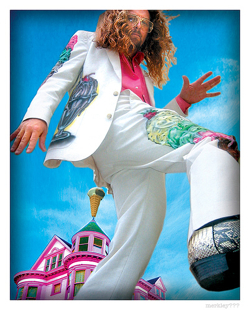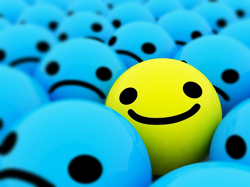January 5th, 2007 by Steve Pavlina
After my last article on
experiencing creativity,
there was a question in the resulting forum discussion about how to
enter this highly creative flow state, the state where you lose all
sense of time, your ego vanishes, and you become one with the task in
front of you. Is this peak creative state a rare chance event, or can
it be achieved consistently?
For me the creative flow state is a common occurrence. I usually
enter this state several times a week, staying with it for hours at a
time. I’m able to routinely enjoy the flow state as long as I ensure
the right conditions, which I’ll share with you in a moment.
My first memories of habitually entering this flow state date back
to the early 80s when I was learning BASIC programming. After school
I’d rush through my homework in order to spend hours in front of my
Atari 800 writing, testing, and tweaking programs just to see what the
machine could do. Sometime around 8pm I’d notice my hunger, realize
that the family had already eaten dinner, and ask my mom, “Why didn’t
you call me when dinner was ready? I’m starving!” She’d
invariably claim to have called me 3-4 times, usually with me verbally
acknowledging, “I’ll be there in a minute.” Either I had no
recollection of this happening, or it was like trying to recall a fuzzy
dream memory. Did she really call me, or did I imagine it? I was so
engrossed in my creative hobby that I became oblivious to what was going
on around me. If I did acknowledge my mom, it must have been an
unconscious reaction.
For the past 25 years, I’ve relied heavily on these tune-out-the
world creative periods for a variety of tasks encompassing many
disciplines: computer programming, game design, arts and crafts, web
development, articles, speeches, Photoshop work, sound effects
recording, school papers, and lots more. Today these periods are
essential for my blogging work.
For most of my life I took these creative spurts for granted. As a
teenager I attributed it to being left-handed. But I later realized
I’d developed a process for initiating and sustaining these creative
periods. I can’t guarantee these rules will be as effective for you as
it is for me, but I suspect that with a little practice you’ll find them
quite effective.
Here are my 7 rules for optimizing the highly creative flow state:
1. Define a clear purpose.
To enter the flow state, you need a goal. Decide what you want to
create and why. Vague intentions don’t trigger the flow state.
If I sit down with the thought of cranking out a new article or doing
some generic website work, I rarely enter the flow state. I need a
more focused intention like, “I’m going to write an article about my
rules for creativity.” Children do this automatically. A simple,
straightforward purpose like, “Let’s build a castle with these blocks”
is all you need.
If you’re working on a large multi-session project like a book, state
your purpose for this single creative session. What do you want to
accomplish right now? Create an outline? Design a character? Write a
scene?
Don’t overqualify your purpose. You need enough clarity to give
yourself a direction but not so much as to put yourself in a box. You
purpose should be an arrow, not a container. Adding too
many constraints can stunt your creativity by limiting your options.
2. Identify a compelling motive.
In addition to a goal for your creative session, you need a reason to
be creative. Why does this task matter to you personally? What
difference will it make if you can be creative? Why do you care?
If I don’t care about a task or project, I can’t summon the flow
state. In school I could trigger the flow state easily when doing
assignments I liked, but if I thought an assignment was pointless or
stupid, I’d only go through the motions without crafting anything
particularly original.
It’s much easier to be creative doing what you want to do vs. doing
what you have to do. One thing that often happens when people quit
their jobs and go to work for themselves is that their creative output
soars. Even among those strange job-holding folk, being able to select
your next project from a few options is often used as a reward,
especially in technical fields.
The more compelling the motive, the more likely you are to summon
high levels of creativity. Imagine that your inner creative resources
are lazy, and they need a damned good reason to roll out of bed and go
to work for you.
My best creative output occurs when I’m working on something that will simultaneously benefit myself
and
others. Being at the extremes of either selfishness or selflessness
isn’t effective. I write my best articles when I’m passionate about the
topic and expect my writing will genuinely help
people. The anticipated impact needn’t be huge — writing a humorous
piece to make people laugh is a perfectly effective motive.
3. Architect a worthy challenge.
To awaken your full creative potential, the difficulty of your
creative endeavor must fall within a certain challenge spectrum. On a
scale of 1-10, where 1 is trivially easy and 10 is impossible, I’d say
the optimal creative range is 5-9 with a 7-8 being ideal.
If a task is too easy, you don’t need to be particularly creative, so
your creative self will simply say, “You can manage this one without
me. Come back when you have something worthy of my attention.”
If you consider a task too hard or too complicated, your beliefs will
get in the way of your creativity, and you’ll end up with a
self-fulfilling prophecy of failure. Even if you manage to hit the
creative zone, it will be unsustainable because you won’t recognize the
validity of the ideas that come through. When you feel a task is nearly
impossible, it’s usually because the solution, if it exists, is way
outside your comfort zone. These are the kinds of problems where your
creative self will come up with solutions like “quit your job” or “end
your marriage.” The solutions may be perfectly valid, perhaps even
brilliantly correct under the circumstances, but you’ll be very
resistant to accepting them.
What if you want to do creative work that doesn’t fall within the
optimal challenge spectrum? Fortunately there are many ways you
can modify a task to adjust the challenge level. If a task is too easy,
you can add more constraints, just as you’d add weight plates to a
barbell. If a task is too hard, you can break it down into smaller
chunks, like tackling a page or a chapter instead of a whole book.
Sometimes when I work on an easy task, I’ll boost the difficulty to
push myself into the optimal creative range. If I’m writing an article
that seems too easy for me, I can increase the challenge by injecting
humor, writing in an unusual style, or adding some other twist. A while
back I wrote a popular article on the
Meaning of Life,
which was a personal account of what I consider to be the most
difficult period of my life (getting arrested for grand theft and being
expelled from school). Writing the article didn’t require much
creativity because recalling those experiences was a straightforward,
linear task. To introduce more creativity into the piece, I decided to
use Depeche Mode song and album titles for all the subheadings. The
challenge was to make them fit the text without seeming too odd. This
extra constraint made composing that 6400-word article a lot more fun.
Whenever you read an article of mine where the style seems a bit
unusual, it’s a safe bet I’m boosting the challenge to be more creative.
You might assume a very easy task is a good thing, but being in the
sweet spot of challenge is better. Tackling something that’s too easy
is like strength training with weights that are too light. It’s
mind-numbingly boring and won’t produce results. Being properly
challenged is more fun, helps you grow, and yields a meaningful sense of
accomplishment.
4. Provide a conducive environment.
You’ll find that certain environmental conditions make it easy for
you to enter the flow state, while other conditions make it nearly
impossible. The optimal environment varies from person to person, so
you’ll need to experiment to find what works best for you.
Some people seem to work best in stimulating, active environments. Author Malcolm Gladwell (
The Tipping Point,
Blink) claims to have written at least one of his books entirely in public places like coffee shops.
I work best in a private, quiet environment. I do virtually all my
creative work alone in my home office with the door closed. I’ve
previously written an article on
Creating a Productive Workspace,
so I won’t reproduce that advice here. But the basic idea is that
different workspace layouts can have a noticeable effect on your
creative output. I’ve found certain feng shui principles helpful, such
as positioning my desk to be in the “commanding position” with my back
to the wall and where I can see the door.
When I’m doing challenging creative work, I usually don’t listen to
background music at all, although sometimes I’ll play non-vocal new age
or classical music. However, I’ll listen to trance music (with or
without vocals) when plowing through routine tasks. I suggest
experimenting with different types of music to see what effect it has on
your ability to reach and maintain the flow state.
5. Allocate a committed block of time.
Imagine your mind is like a computer. The more you can take
advantage of the computer’s resources, the more creativity you harness.
To free up the most resources for your creative task, you first need to
unload all nonessential processes. This means closing programs like
Ego 1.0,
Physical Sensations 1.3, and
Distracting Thoughts 2.0. If you want to maximize your creativity, you need to hog as much of the CPU as you can get.
It normally takes me about 15 minutes to begin to enter the flow
state, and I’m solidly entranced after about 45-60 minutes. By the end
of the first hour, I’m just getting into the task. My real creative
output happens in hours 2, 3, 4, and beyond.
It isn’t until after the first hour that the creative task is fully
loaded into my mental RAM, and my CPU is finally dedicating its full
capacity to the task at hand. This is the state of deep concentration.
In this state distracting thoughts that would otherwise knock me out of
state no longer arise. I’m completely locked on, and I’ll keep plowing
through my creative work until stopped by a force like fatigue or
hunger.
When I begin an article, I don’t know how many words it will be or
how long it will take to finish. Sometimes I’m done after 90 minutes;
other times I’m still going after 5 hours. When I’ve written articles
to target lengths (like 1000 words) or to target times (like 2 hours), I
usually churn out the kind of vapid drivel you’ll find in fluffy print
magazines. With a tight deadline I can still finish something, but it
won’t be anywhere near what I create with an open-ended schedule.
I recommend a minimum continuous block of 3 hours for a serious
creative task, preferably closer to 6 hours. That may sound like a lot,
but once you’re cranking away in that glorious flow state, you’ll
barely even notice the passage of time. It’s better to allocate too
much time than too little. It’s a real downer to finally hit the flow
state and have to stop after 30 minutes because you must attend to
another commitment. Feel free to schedule your routine tasks into 30-60
minute blocks, but give yourself as much time as possible for highly
creative work.
6. Prevent interruptions and distractions.
If you can’t keep yourself from being disturbed by urgent phone
calls, emails, or drop-in visitors, you won’t consistently achieve and
maintain the flow state. You must do whatever it takes to prevent
unnecessary interruptions during your creative periods. Make
arrangements to ensure you won’t be disturbed except in an absolute
emergency.
Once I’m in the flow state, I can handle a minor interruption like a
bathroom break or grabbing a snack without falling out of state. My
mind will still be churning on the original task, and I can easily pick
up where I left off. But if I do something that requires a context
change such as making a phone call or checking my email, I’ll begin
losing my flow state.
When I begin a creative task, I tell Erin I’m “going to my cave,” so
she knows not to interrupt me. I clear my desk of unnecessary items,
ignore the phone, disable my instant messenger, and close all programs
except those required for the task at hand. I do what I can to prevent
interruptions, but even when they occur I usually just ignore them.
If you work for someone who expects you to produce creative work but
makes it impossible for you to tune out interruptions, fire your boss.
If you can’t maximize your creative output, you’ve lost your
greatest leverage for producing value. That will cripple your earnings
potential, since your income is a function of your ability to produce
value.
Respect the value of your creative periods, and don’t permit yourself to be interrupted.
7. Master your tools.
Creating a tangible piece of creative work requires tools such as a
computer, guitar, or pencil. Even though it may take years, you must
achieve basic competency with the tools of your trade before you can
consistently enter the flow state.
Put in the time to take those piano lessons, attend those programming
classes, or devour those Photoshop tutorials. Of course there are
degrees of mastery, but the more you develop subconscious competence
with your tools, the easier it is to enter and maintain the flow state.
When you’re in the flow state, you won’t be worrying about where your
fingers need to be, what buttons you need to click, or what words you
need to type. Your subconscious will handle those details for you while
you remain focused on the high level composition.
The reason I can maintain the flow state when writing articles is
that I’ve taken the time to develop my writing skills and to master the
software I use to turn my ideas into published works. I don’t pretend
to be a literary genius, but I’m competent at turning my thoughts into
words, sentences, and paragraphs without much difficulty. On my first
high school essay, I did the best I could and received a C+. I
didn’t understand the basic concepts of composition like unity and
coherence. But I had a fantastic English teacher in my freshman and
sophomore years. He was challenging and even a bit sadistic, but I put
in the effort to learn grammar and composition and earn an A in his
classes. By the time I graduated high school, I could write articles,
essays, and reports with relative ease.
On the other hand, when I’m not competent enough with my tools, I
can’t enter the flow state. Despite using Adobe Photoshop for many
years, I never invested the time to master its complex interface because
I only used it intermittently. Consequently, I seldom achieve the flow
state when using Photoshop because I spend too much time consciously
thinking about the low-level action steps. This stunts my creativity
because I remain stuck in my left brain instead of shifting into my
right brain.
After your creative flow state churns out your first draft, you’re
always free to go back and edit it later. Get the creative, right-brain
part done first. Then go back and do a logical, left-brain pass to
make refinements and correct any problems. For my articles that
includes spell checking, tightening up the wording, making cuts, etc.
Entering and maintaining the highly creative flow state is a skill,
not a blessing, an accident, or a fluke. By habitualizing the rules
above and adapting them to your situation, you can experience the flow
state as a regular, perhaps even daily, occurrence. And once you learn
to harness the power of flow, your creative output will soar.
Source: http://www.stevepavlina.com/










 The
longer you work at creating things, whether it’s software, websites,
essays or paintings, the greater the odds you’ll hit a day where you
don’t feel like doing it anymore. Up until then, you may have heard
others describe burnout, but you just shrugged it off as superstition,
or perhaps believed yourself immune. But the day it hits you, the world
seems suddenly grey. What was once fun and challenging feel stupid and
annoying. Or perhaps the things that used to motivate or move you don’t
resonate at all. You feel nothing for them. It all just seems like so
much more crap to deal with. If this sounds familiar, or you fear that
this day is in your future, this essay is for you.
The
longer you work at creating things, whether it’s software, websites,
essays or paintings, the greater the odds you’ll hit a day where you
don’t feel like doing it anymore. Up until then, you may have heard
others describe burnout, but you just shrugged it off as superstition,
or perhaps believed yourself immune. But the day it hits you, the world
seems suddenly grey. What was once fun and challenging feel stupid and
annoying. Or perhaps the things that used to motivate or move you don’t
resonate at all. You feel nothing for them. It all just seems like so
much more crap to deal with. If this sounds familiar, or you fear that
this day is in your future, this essay is for you. Using
the well example again, what would you do if you ran out of water?
Would you become one with your couch, pizza in hand, watching movies all
day long, leaving it to the fates to decide if you’ll ever drink water
again? I think not. You’d go out to the store, or perhaps to a
neighbor’s house and ask to borrow some of theirs. Burnout is entirely
survivable. Creative people get burnt all the time, to varying degrees,
and many of them develop the habits that allow them to come back,
sometimes stronger or more motivated that they were before. The well
will fill again all on it’s own, unless you do something really really
stupid (Say, start taking drugs, staying all night and trying to plow
through even though that never works for you, giving up completely and
joining the army, etc.)
Using
the well example again, what would you do if you ran out of water?
Would you become one with your couch, pizza in hand, watching movies all
day long, leaving it to the fates to decide if you’ll ever drink water
again? I think not. You’d go out to the store, or perhaps to a
neighbor’s house and ask to borrow some of theirs. Burnout is entirely
survivable. Creative people get burnt all the time, to varying degrees,
and many of them develop the habits that allow them to come back,
sometimes stronger or more motivated that they were before. The well
will fill again all on it’s own, unless you do something really really
stupid (Say, start taking drugs, staying all night and trying to plow
through even though that never works for you, giving up completely and
joining the army, etc.) In
then end, I’ve found that talking with other people won’t dramatically
change the way you feel. It’s important to talk and express things,
since expressing feelings is the only way to work through them, but in
the end, change only comes from within. Change is slow, tricky and
unpredictable, but everyone has certain triggers or experiences that
help them shake things up more than others. Since everyone’s different,
the approaches for how to work through it often have to be discovered by
you. Here’s some of the things that I know have worked for me, and
other designers and engineers I’ve worked with, but I recommend serious
experimentation on your own:
In
then end, I’ve found that talking with other people won’t dramatically
change the way you feel. It’s important to talk and express things,
since expressing feelings is the only way to work through them, but in
the end, change only comes from within. Change is slow, tricky and
unpredictable, but everyone has certain triggers or experiences that
help them shake things up more than others. Since everyone’s different,
the approaches for how to work through it often have to be discovered by
you. Here’s some of the things that I know have worked for me, and
other designers and engineers I’ve worked with, but I recommend serious
experimentation on your own: After
you’ve gone through it once, you might fall victim to the arrogance of
invulnerability. The false idea that since you’ve been burnt to a crisp
once and survived, you can do it again. Don’t be stupid. It’s pure
denial you’re feeling, not confidence. As long as you take on tough
assignments and push yourself creatively you run the risk of going to
far, and to live up to your potential as a creative person, you have to
find ways to push yourself without pushing too far.
After
you’ve gone through it once, you might fall victim to the arrogance of
invulnerability. The false idea that since you’ve been burnt to a crisp
once and survived, you can do it again. Don’t be stupid. It’s pure
denial you’re feeling, not confidence. As long as you take on tough
assignments and push yourself creatively you run the risk of going to
far, and to live up to your potential as a creative person, you have to
find ways to push yourself without pushing too far.
